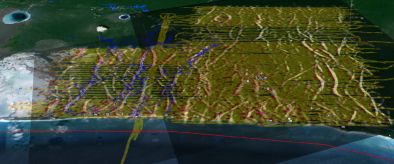News
Update May 2018
From 19 to 30 March 2018 another stay in Mexico / Tulum took place. During this time, a series of activities and events around the World Water Day 2018 were scheduled, mainly initiated / organized by our partner Amigos de Sian Ka'an in schools and public spaces. The small Citizen Science project was also presented on the occasion. As it turned out, the project's content and objectives fit perfectly into the growing diversity of local activities as an expression of increasing public attention for the groundwater issue in Tulum ...
» more
The problem: advancing research on a complex groundwater regime with the help of citizens
In Tulum there is a 10 years (2016) long scientific collaboration of the NGO Amigos the Sian Kaan, dedicated to te preservation of the natural and cutural heritage of the region, and the Geological Survey of Austria, namely its department for geophysics, conducting eg. spectacular AEM-helicopter scanning of the hidden groundwater rivers as seen in the image above. However, critical findings hide in the scientific community with little effect on the public awarness of citizens and decisionmakers about value and violability of the unique water resource. Moreover, citizen could help in advancing the fascinating research - but how to put this together? Click to learn ...
Now, in 2016, the scientific studies already run for 10 years and a lot of data was acquired especially within projects 'Xibalba' and 'Xplore'. But there are two issues with this research:
1) Scientific Issue
In the base project 'Xibalba', one essential approach is innovative generation of a hydrological model which enables estimation of capacity, dynamics, and robustness of the ground water resource. Such a model can potentially estimate the response of the groundwater system to different impacts as heavy rain fall, storm floods, sea level rising, increasing water demand, or simulate spreading of pollutants.
With this capability the model could serve as an important tool supporting urban development planning.
But it needs input data - the more and the more significant, the better.
Therefore, geophysical and hydrogeological surveys were conducted in the air, on ground and in the water filled caves. However, the measurements were temporally and spatially restricted to a certain number of points and/or few weeks per year.
The model could be significantely advanced by a better coverage of data in time and space - that's the scientific issue.
2) Socio-economic issue
As in other common towns, the water comes out of the water tap. the rest is invisible. Local population uses freshwater through private wells or the public water supply which operates strong pumps in few cenotes.
Lagoons and cenotes seem to be fine and clear and serve
as basis for touristic boat trips, fishing or cave and cavern diving or snorkelling as well as the study field for high specialized exploration divers and some international scientific collaborations as ours.
The large underlying karst water regime keeps invisible to the normal citizen, so there is no idea about its size, structure, and sensitivity or indication for degrading water quality. Thus, the public interest or identification with the resource remains at rather low level.
But risky dives in the conduit system directly beneath the city and first analysis of wells, cenotes and lagoons, conducted in course of the projects 'Xplore' and 'Xibalba' already show indication of upcoming threats.
The fresh water is concentrated in a top layer, only several meters thick beneath the town, and thinning to zero at the shore - beneath the fresh water layer there is salty seawater. The freshwater layer is endangered by urban development, increasing water demand, imperfectly sealed sewage systems and waste deposits prone to leaks. So, potential and real pollution threatens the freshwater resource, the nearby Sian Ka'an biosphere reserve (a UNESCO world heritage), the barrier reef, cenotes, hence important touristic income, local culture and nature.
So there is the need for raising public and decisionmakers awarness of the importance and sensitivity of the whole groundwater network and for directing urban development into a realistic and sustainable course.



